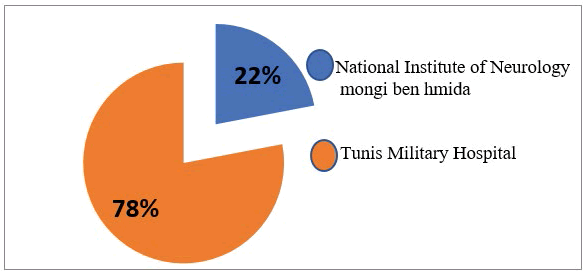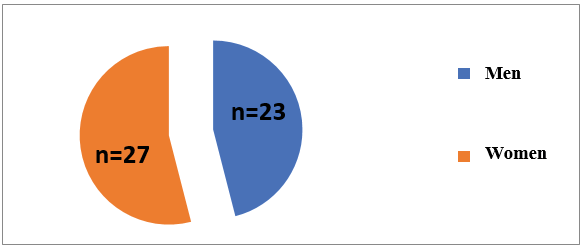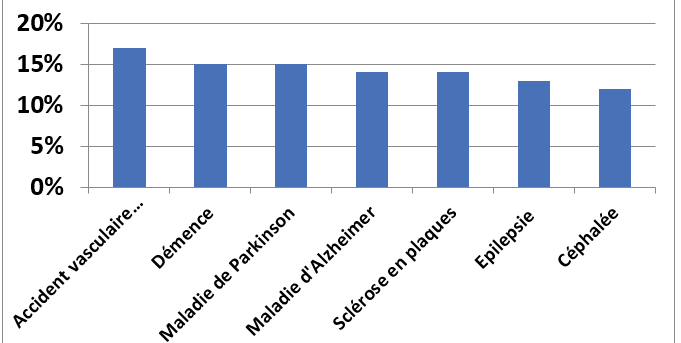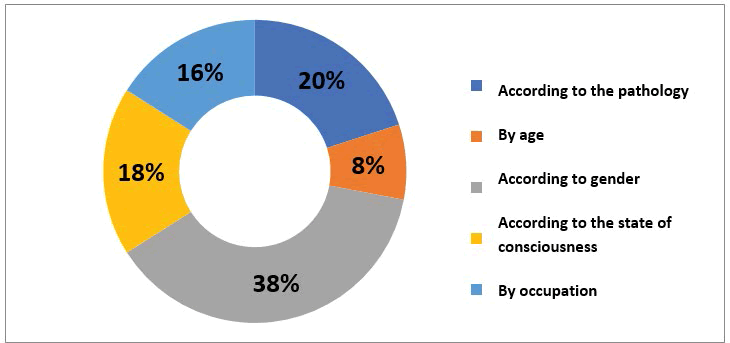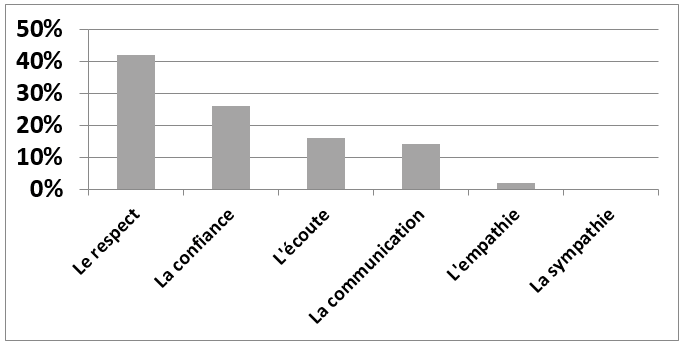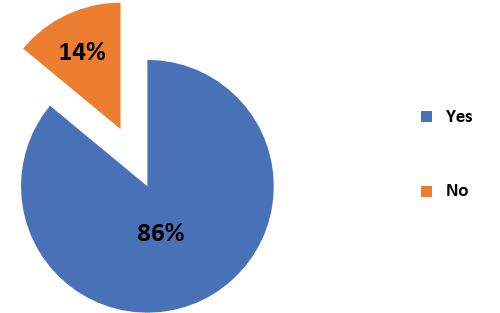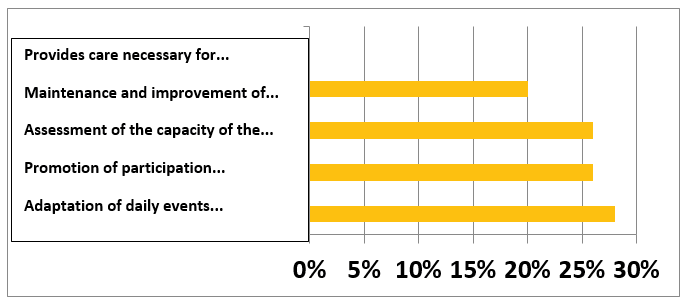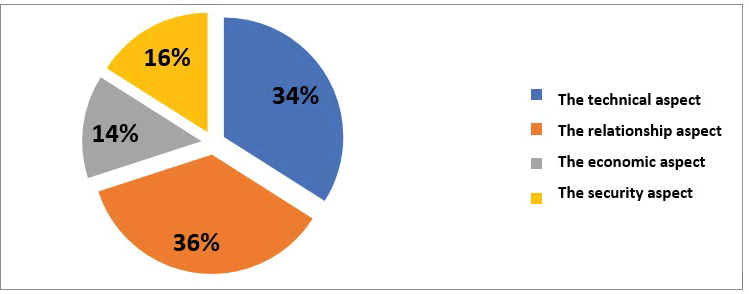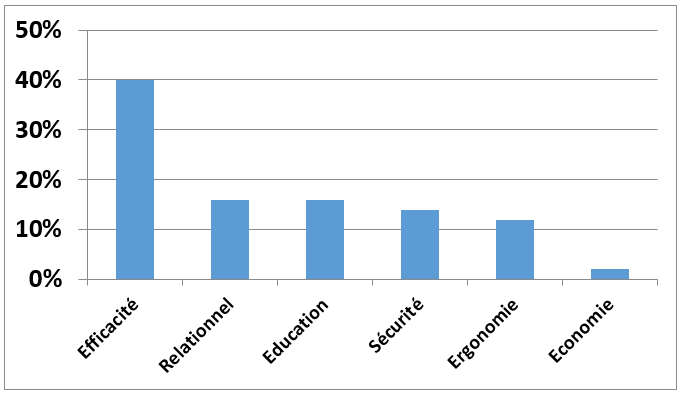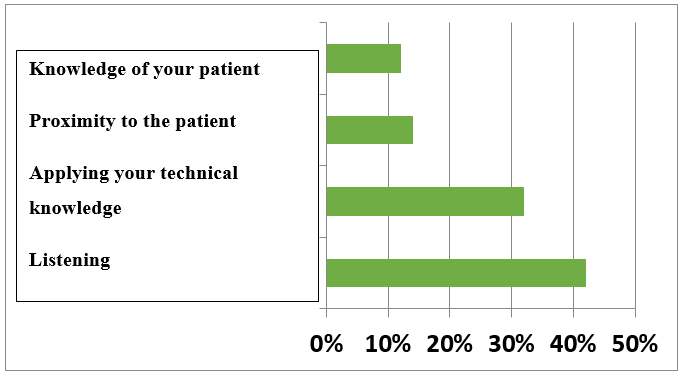Perspective - Clinical Investigation (2022) Volume 12, Issue 3
Nursing support for a patient with a chronic neurological pathology
- Corresponding Author:
- Imededdine Ben Jeddou
Tunis Medical Faculty
Tunis Elmanar University, Tunisia
E-mail: i_benjeddou@yahoo.fr
Received: 14-March-2022, Manuscript No. fmci-22-56867; Editor assigned: 16-March-2022, PreQC No. fmci-22-56867 (PQ); Reviewed: 24-March-2022, QC No. fmci-22-56867 (Q); Revised: 25-March-2022, Manuscript No. fmci-22-56867 (R); Published: 31-March-2022; Doi: 10.37532/2041-6792.2022.12(3).60-68
Abstract
Introduction: Today, the impact of chronic neurological pathology on the patient is heavy on several levels. This makes nursing support a pillar in the care. The nursing role is a pivotal role but remains little valued. Hence the aim of our work is to assess the nursing role in supporting patients with chronic neurological disease.
Methods: This is a descriptive and analytical study that looked at the evaluation of nursing support for patients with chronic neurological pathology. We conducted a questionnaire with 50 nurses working in different departments of the Main Military Hospital of Instruction in Tunis and at the Mongi Ben Hamida National Institute of Neurology.
Results: More than three quarters of the interviewees worked at the Main Military Instruction Hospital in Tunis and a quarter worked at the Mongi Ben Hamida National Institute of Neurology. Concerning the patient, strokes were the chronic neurological pathologies most reported by nurses, 16%. While migraine, headache, epilepsy was reported less than 15% different. The majority of our population, 80%, found the integration of the patient in the therapeutic process to be important. Less than half of the population found that the caregiver/caregiver relationship is mainly based on respect. While trust, communication and listening were found to be less than 30% different. Eighty-two percent of the population questioned stated that there is no training aimed according to our work, we must conduct a field survey since their behavior should be assessed with a more objective eye by an evaluation grid of the support of a patient in neurology and a checklist in order to guarantee the efficiency of the management of paramedical personnel and increase the reliability of our results.
Keywords
Accompaniment • Nurse • Patient • Pathology • Neurological
Introduction
Chronic neurological disorders are diseases of the central and peripheral nervous system affecting the brain, spinal cord, peripheral nerves and the vegetative nervous system. These include epilepsy, Alzheimer’s disease, cerebrovascular diseases, migraine, multiple sclerosis and Parkinson’s disease.
According to the World Health Organization (WHO), hundreds of millions of people worldwide have neurological disorders. Approximately 6 million people die from stroke each year. More than 50 million people worldwide suffer from epilepsy. An estimated 47.5 million people suffer from dementia, with 7.7 million new cases each year. Alzheimer’s disease is the most common cause of dementia, described in 60%-70% of cases.
Management of the majority of chronic neurological diseases remains symptomatic. Hence the interest of psychological management and accompaniment of these patients. The accompaniment of patients with a chronic neurological disease is in the majority of cases neglected by the healthcare staff for lack of training and interest in this side. Few studies in the literature have been interested in the accompaniment of patients with chronic neurological pathologies by health care personnel, and we have seen the value of conducting a study to that end in order to highlight the nursing role.
The aim of our work was to implement the importance and usefulness of nursing support for patients with chronic neurological disease.
Methods
Type of study
This was a descriptive and analytical study that focused on the evaluation of nursing accompaniment in patients with chronic neurological pathology.
We conducted a questionnaire with 50 nurses working in different departments of the Military Primary Training Hospital of Tunis (HMPIT) and the National Institute of Neurology Mongi Ben Hamida. Our study was conducted over 2 months between March and May 2021.
Materials
The inclusion criteria: Nurses working at HMPIT or the Mongi Ben Hamida National Neurological Institute have been included in our study for at least one year.
The criteria for non-inclusion: Nursing assistants in training, administrative staff and secretaries were not included.
The exclusion criteria: Excluded from the study:
- Nurses who refused to answer the questionnaire.
- Incomplete questionnaires that make them inoperable
Study protocol
We developed a questionnaire of 17 multiple-answer questions (Appendix 1) that focused on:
- Epidemiological characteristics of the study population: age, gender and area of ownership.
- Nurses’ knowledge of the patient: types of chronic neurological conditions encountered daily by nurses, types of patients (Independent, outpatient or cooperative during care), Criteria for the distribution of patients in service rooms and the importance of patient integration in the therapeutic process.
- The relationship between caregiver/caregiver: the basics of the relationship between caregiver/caregiver, the caregiver’s ability to establish a relationship of trust with the caregiver and to listen to them, the nurse’s duty to respect the patient and the nurse’s objective during the patient’s care.
- The quality of nursing care: the major difference between quality care and quality care, the most important criterion of quality care, the importance of quality in a care, the main element allowing qualifying a relational care as quality.
- Perspectives: Presence of training aimed at improving the nursing accompaniment of a patient with chronic neurological pathology in hospitals.
Literature search
We have used as bibliographic resources the catalogues of the library of the School of Military Health (memoirs and theses), the journal bouquets and the bibliographic databases and the following search engines:
- Pub med: http://www.ncbi.nlm.nih.gov/pubmed
- Direct Science: http://www.sciencedirect.com
- Google scholar: http://scholar.google.com
- Cochrane: http://www.thecochranelibrary.com/view/0/index.html
The keywords used were: Coaching, Nurse, Patient, Pathology, Neurological
Statistical analysis (Data management and analysis)
The input and analysis of the results was done using the SPSS 20 computer tool. The statistical exploitation was presented in the form of tables and graphs.
Ethical Considerations
We have no conflict of interest to declare. Ethically, we have respected the transparency and authenticity of the answers. The information was treated anonymously.
Results
Epidemiological characteristics of the study population
We had the participation of 50 nurses whose distribution by area of ownership (Civilian or Military) was summarized in Figure 1. Three quarters of the interviewees worked at HMPIT.
The average age of our population was 23 years 9 months, with extremes ranging from 21 to 25 years with a ration sex of 0.85. Figure 2 shows the distribution of nurses by gender.
Nurse knowledge of the patient
Regarding patient knowledge, the interviewees were interviewed by 4 multiple-choice questions.
Question 1: What types of chronic neurological diseases do you encounter on a daily basis?
In terms of knowledge of neurological pathologies, stroke was the most commonly reported chronic neurological pathology by nurses at sixteen percent (n=8) (Figure 3).
Question 2: How do you view your chronic dependent patients?
Patients were considered in three ways by nurses (Table 1).
|
Patient types |
Number |
Percentage |
|
Co-operatives during care |
18 |
36% |
|
Independent |
14 |
28% |
|
Dependent |
18 |
36% |
Table 1: Types of patients by 50 nurses surveyed.
Question 3: What are the criteria for allocating patients in the rooms of the service?
Sex was selected by thirty-eight percent (n=19) of the nurses interviewed as the most important patient distribution criterion to consider (Figure 4).
Question 4:Do you think that the integration of patients into the therapeutic process is essential?
Forty nurses found that the integration of patients into the therapeutic process is essential. Twenty percent (n=10) of the interviewed population believed that this integration is not important (Table 2).
|
Importance of integration |
Frequency |
Percentage |
|
Significant |
40 |
80% |
|
Not significant |
10 |
20% |
Table 2: The importance of patient integration in the therapeutic process.
The caring/caring relationship
Regarding the caring/caring relationship, the interviewees were asked 5 multiple-choice questions.
Question 1: For you, what is the primary basis of the caring/caring relationship?
Forty-two percent (n=21) of the target population found that the basis of the caring/caring relationship. Only seven people saw that empathy can be a foundation of this relationship (Figure 5).
Question 2: Are you able to establish a relationship of trust with the patient?
The entire study population (n=50) found that the nurse had a strong ability to establish a trusting relationship with the patient (Table 3).
|
Capacity |
Number |
Percentage |
|
High capacity |
50 |
100% |
|
Low capacity |
0 |
0% |
Table 3: The patient’s ability to establish a relationship of trust with the caregiver.
Question 3: Are you listening to the person when the diagnosis is announced?
Eighty-six percent of nurses surveyed (n=43) said they were listening to the person when the diagnosis was announced (Figure 6).
Question 4: Do you have to have respect for the patient living with a chronic neurological disease?
Fifty-eight percent (n=29) of nurses said that respect for the patient is essential (Table 4).
|
Have respect for the patient |
Number |
Percentage |
|
Yes |
21 |
42% |
|
No |
0 |
0% |
|
Indispensable |
29 |
58% |
Table 4: The duty of the nurse to have respect for the patient with a chronic neurological disease.
Question 5: Do you think that the nurse's goal during the accompaniment is? (Figure 7)
Quality of care
Regarding the quality of care, interviewees were asked by 4 multiple choice questions.
Question 1: In your opinion, what is the major difference between a treatment and a quality care?
Thirty-six percent (n=18) said that the relational aspect is the major difference between quality care and quality care, while only seven nurses found that the economic aspect made the difference between quality care and quality care (Figure 8).
Question 2: Among these criteria aimed at analyzing the quality of a treatment, what is the most important criterion between them?
The quality of care was the measure of effectiveness according to forty percent (n=20) of the target population. Only 6 people found ergonomics to be the most important criterion (Figure 9).
Question 3: In what type of care is quality more important in your opinion?
More than half of nurses (n=26) found that quality is more important in technical care as shown in Table 5.
|
The importance of quality in care |
Number |
Percentage |
|
Relational |
12 |
24% |
|
Technique |
26 |
52% |
|
Educational |
12 |
24% |
Table 5: The importance of quality in care.
Question 4: What of the following main elements allows you to qualify relational care as "quality"?
Twenty-one of the fifty nurses, or forty-two, said that listening is the main element that qualifies relational care as being of "quality" (Figure 10).
Outlook
In hospitals, are there training courses aimed at improving the nursing support of a patient with a chronic neurological pathology?
Eighty-two percent (n=41) of the population surveyed answered no (Table 6).
|
Response |
Number |
Percentage |
|
Yes |
9 |
18% |
|
No |
41 |
82% |
Table 6: Presence of training aimed at improving the nursing support of the patient.
Discussion
The main results
We had the participation of 50 nurses from different workplaces. The average age of our population was 23 years 9 months, with extremes ranging from 21 to 25 years with a sex ratio of 0.85. More than three-quarters of the interviewees worked at the Tunis Main Military Training Hospital. In terms of nurses' knowledge, strokes were the most commonly reported chronic neurological conditions among nurses, at 16%. While migraine, headache, epilepsy were reported in less than 15%. Eighty per cent found that the patient’s integration into the therapeutic process was important. With respect to the caring/caring relationship, less than half of the population found that the caring/caring relationship is primarily based on respect. While trust, communication and listening were found in less than 30% gap. Nurses were asked about the quality of care. Thirty-six percent said that the relationship aspect is the major difference between care and quality care. As well as 24% found that the technical aspect is also important in a quality care while the relational aspect and the economic aspect were found in less than 20% of difference. Eighty-two per cent of the population surveyed stated that there is no training to improve the nursing accompaniment of a patient with a chronic neurological pathology. Hence the need to establish continuing training for nurses in chronic neurological diseases.
Bias and limitations of our study
Like all scientific work, our study suffered from some failures. One bias was the small number of nurses who belong to the different working institutions. A larger workforce could have increased the reliability and significance of the results. The second bias was the fact that this topic covered all chronic neurological pathologies in general. Whereas if we talked about a specific pathology, this work could have been more interesting. However, the third bias was the prospective nature of our study based on data collected from the questionnaire from nurses who may lack objectivity. In addition, many circumstances have led to the lack of availability and interest in my research including mandatory containment as part of Covid-19 prevention.
Strengths of our study
To the best of our knowledge, no study has looked at that. It was a work in progress. This topic talked about chronic neurological pathologies that are in vogue and quite common. The purpose of this study is to assess the nurse’s skills and knowledge about nursing accompaniment for a patient with chronic neurological disease based on a representative and vision of the caregiver to help improve performance of nurses. This will help identify and correct workplace failures and improve the quality of training provided to nurses.
Discussion of results
Identification of the study population: For nurses, the statistical study showed a female predominance of 27 nurses and 23 nurses. The average age of our population was 23 years 9 months, with extremes ranging from 21 to 25 years. More than three quarters of the interviewees worked at the Tunis Main Military Training Hospital.
Nurse knowledge of the patient: Stroke was the most commonly reported chronic neurological condition among nurses, at 16%. While migraine, headache, epilepsy was reported in less than 15% of differences. The strong knowledge of strokes is due to the frequency of these pathologies. Unlike the other pathologies that were less reported because of two facts, on the one hand they are managed in an outpatient setting, on the other hand they are pathologies that are less frequent. According to the WHO, hundreds of millions of people worldwide have neurological disorders. Approximately 6 million people die from stroke each year. More than 50 million people worldwide suffer from epilepsy.
It is estimated that 47.5 million people suffer from dementia, with 7.7 million new cases each year. Alzheimer’s disease is the most common cause of dementia, accounting for 60%-70% of cases. The global prevalence of migraine which is one of the forms of headache is greater than 10%. We have seen the lack of awareness of other pathologies by nurses, which is a weakness in the knowledge of our population.
Nurses were divided into 3 categories for this question. From where each met different chronic dependent patients. Seventy-two per cent of nurses, or 36 per cent on each side, found patients who were cooperative during care as well as dependent patients. From this we see that nurses are unable to choose between patients, which highlights the need to develop retraining for caregivers in order to improve their professional skills and objectivity.
Sex was chosen by 38% of nurses interviewed, or 19 out of 50, as the most important criterion for the distribution of patients. Through their answers, it is noted that nurses do not give enough importance to the pathology which is the most important criterion of distribution since it is a tool of assistance in the therapeutic process. Hence the interest in continuing training nurses in chronic neurological diseases.
Forty out of 50 nurses found that the integration of patients into the therapeutic process is essential. Indeed, one-fifth of the population interviewed thought that this integration is not important, whereas the entire target population was found to say that the integration of patients in the therapeutic process is essential. The result is that the nurses have a lack of objectivity based on this question.
The caring/caring relationship: Forty-two percent of nurses found that the basis of the caring/caring relationship is respect. While trust, communication and listening were found in less than 30% gap. This brings us back to the failures related to the caring/caring relationship. Indeed, in this relationship respect must be reciprocal in the first place. Communication is important, trust must be established between nurse and patient. The skills to be developed are primarily the ability to accept the patient without value judgment, with respect as well as respecting the patient’s desire, rhythm, lifestyle and values. Then, the development of listening abilities but also make themselves available and allow the person or the entourage the expression of emotions.
The entire population interviewed felt that the nurse has a strong ability to establish a relationship of trust with the patient, which implements the importance of trust in the caring/caring relationship. Moreover, according to Braissant Claudine, “The purpose of informing the patient may be to reduce anxiety due to the unknown and to establish a trusting relationship that embodies collaboration”. However, the behaviour of nurses in the field of work is not similar to their responses to the questionnaire. Their behaviour should be assessed with a more objective eye through an assessment grid.
The majority of nurses stated that they are listening to the person when the diagnosis is announced. While 14% said they were not listening to the person at the time of the announcement of the diagnosis. Listening is one of the pillars of the caring/caring relationship. Indeed, according to the testimony of Carole Thizy, listening to the patient is important in our professional practice since it is evidence to properly care for and contribute to the benevolence due to the person.
Fifty-eight per cent of nurses said that the duty to respect the patient is indispensable. Indeed, respect is the ability of the nurse to have to make the effort to reverse what she projects on the patient. In order to treat the patient with respect, the nurse must recognize his status as a human being and return to his own feelings of fear and helplessness, face them and treat the patient independently of his projections.
More than a quarter of the target population, or twenty-eight per cent, found that the main objective of nursing accompaniment is to adapt daily care to the needs of the person being cared for. In Michel Fontaine’s study, nursing effectively accompanies life along its continuum to death. Generally speaking, their interventions are therefore more in the care than in the cure. In saying this, we are already introducing an important element of accompaniment.
Quality of Care: Thirty-six percent said that the relationship aspect is the major difference between quality care and quality care, while 17 nurses found that the technical aspect is the difference between quality care and quality care. WHO defines “quality care” as ensuring that “each patient must receive the combination of diagnostic and therapeutic procedures that will ensure the best health outcome, in accordance with the current state of medical science, at the best cost for the same outcome, the slightest iatrogenic risk and to its greatest satisfaction in terms of procedures, results and human contacts, within the healthcare system.
The most important criterion for analysing the quality of care according to interviewees was the effectiveness according to forty percent of the target population. Only 6 out of 50 people found ergonomics to be the most important criterion. Patient satisfaction is a component of quality-of-care assessment. More than half of the nurses found that quality is more important in technical care. According to the WHO, “Quality of care assessment is an approach that ensures that every patient has the diagnostic and therapeutic procedures that ensure the best health outcome”.
Twenty-one of the fifty nurses, or 42%, said that listening is the main element that qualifies relational care as «quality». Active listening is above all a communication technique related to nursing care and maintenance. It facilitates the emergence of information, which implies an inner silence, and which excludes immediate questioning.
Outlook: Eighty-two per cent of the population questioned answered by no, that is to say that there are no training courses aimed at improving the nursing accompaniment of a patient with a chronic neurological pathology.
Conclusion
Today, the impact of chronic neurological pathology on the patient is heavy on several levels. This makes nursing support a pillar in management. The aim of our work is to implement the importance and usefulness of nursing support for patients with chronic neurological disease in the face of the increase in the frequency of people with these disorders and the decrease in the number of treatments effective.
Nursing support for patients with chronic neurological conditions is now a general concern of all healthcare institutions. It is in the majority of cases neglected by the health care staff for lack of training and interest in this area.
Of course, all the results that we had were preliminary and were interpreted with great caution since we evaluated the so-called paramedics and not their behavior in the field of work because of the lack of an evaluation grid. However, the behavior of nurses in the field of work is not similar to their responses to the questionnaire since the theory is different from the practice.
As a result of our work, we need to conduct a field survey since their behavior should be assessed with a more objective eye through a grid of assessment of the accompaniment of a patient in neurology and a check list to ensure the effectiveness of the management of paramedics and increase the reliability of our results.
Conflict of interest
The authors have not declared any conflict of interest with respect to the authorship or publication of this article.
